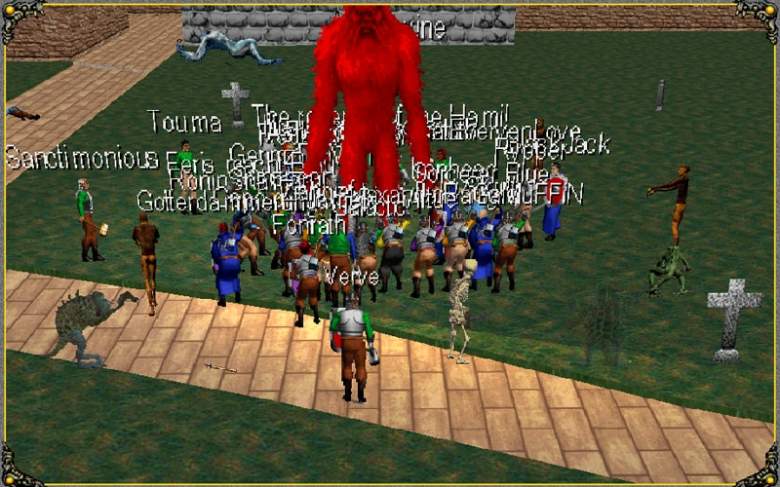
John Hanke is the CEO of Niantic Labs, the company that makes Pokemon Go. (Google Plus)
The success of Pokemon Go has generated immediate interest in the game’s developer, Niantic Labs. You might expect such a phenomenon to be lead by a team of hundreds of employees, but the company is still quite small, consisting of only a few dozen people, according to its LinkedIn page.
The company’s CEO is John Hanke, a man who has had plenty of experience with online games and with mapping programs. Though he has created some brilliant pieces of software, it has taken about 20 years for Hanke to be widely recognized for his creations.
Here’s everything you need to know about John Hanke, creator of Pokemon Go.
1. He Graduated From the University of California, Berkeley
John Hanke grew up in Texas, and he received his bachelor’s degree from University of Texas at Austin.
From there, he attended the Haas School of Business at the University of California, Berkeley, graduating in 1996 with an MBA.
Since 2008, Hanke has been an Haas School Executive Fellow at the University of California, Berkeley, according to the school’s website.
2. He Helped Create Google Earth

John Hanke helped developed software that eventually became Google Earth. (Google Play)
The idea of Pokemon Go actually popped up a few years ago when Google, as an April Fool’s Day joke, announced a fictional product that involved catching Pokemon using Google Maps. That isn’t the only way that the game has ties to Google, though; the creator previously worked for the company.
In 2001, Hanke founded the startup Keyhole, which created a program called Earth Viewer. This allowed users to explore the globe using satellites and 3D mapping technology. It gained some notoriety when it began to be used by news broadcasts, and in 2004, the company was bought by Google for $35 million. Earth Viewer was later renamed Google Earth.
Hanke says he and his team brought this experience to Pokemon Go.
“A lot of us worked on Google Maps and Google Earth for many, many years, so we want the mapping to be good,” he told Mashable.
3. He Worked on The First MMORPG

Meridan 59 was the first major MMORPG. (Meridan59.com)
Pokemon Go was not Hanke’s first experience with large online gaming. In fact, he helped create the first commercial Massively Multiplayer Online Roleplaying Game, Meridan 59, which was released on PC in 1996. It was a sword and sorcery game which required players to pay a monthly fee, as is the case with modern MMORPGs like World of Warcraft.
Hanke said in an interview that these MMOs were essentially an expansion of the success of Dungeons & Dragons, and they were all about the fun of playing a complicated game with friends rather than with a machine. He says that what he learned from Meridan 59 that he brought to Pokemon Go is that playing with real people is always more fun than playing with a computer.
“The challenge and competition of trying to outguess or outmaneuver a real person is infinitely interesting, and it doesn’t get old,” he told Time.”And then the other key thing from MMOs was the social coordination, the social organization, which in MMO worlds are called guilds, of course. That’s something we saw with Meridian 59, they spontaneously formed, and we ultimately built features within the product to support the guilds.”
Pokemon Go has its own versions of guilds with the three teams: Mystic, Instinct and Valor.

Similar to Pokemon Go, Ingress is an online game that users real-world locations. (Ingress)
Pokemon Go is in some ways an evolution of another game that John Hanke created. Ingress, released in 2012, is a science-fiction mobile game in which players must work together to take control of “portals,” which are based on real-life locations. These portals are essentially the equivalent of Poke Stops. It’s a bit more complicated than Pokemon Go, but it follows a similar premise of basing its map on actual places and on having players join teams and all work towards a goal.
Hanke says that both games are so fun and popular as a direct result of the fact that they’re so social.
“That social organization is exactly the same dynamic here. We saw it in Ingress and we’re seeing it in Pokémon Go, it’s just in the real world,” Hanke said.”So instead of getting together with a bunch of avatars in a virtual guild hall, you’re getting together with your friends, meeting and going out together, or meeting up with them some place in the city. It just blends in with real life, which makes it infinitely more interesting to me than something that’s occurring only in this virtual space. Because it’s real. Real friendships are forming.”
Ingress is not just a thing of the past, either. It’s still played in 200 countries around the world, and a game event recently held in Japan saw over 10,000 participants, according to Time.
Although everyone is now falling in love with Pokemon Go, Hanke says that when Ingress first came out, a lot of people were confused about the phenomenon. He saw it as an extremely positive thing for players.
Hanke explained, “When journalists reach out to the community and ask ‘Why are you playing this game? Why are you doing this? Is it weird that people are out in the middle of the night?’ The response is, ‘It’s amazing, it’s changed my life. I’ve met so many new people, I’m seeing the world in a completely different way. I’m walking three miles a day and I was housebound and watching TV all day before I started playing this game.’ It’s positive story after story.”
5. He Says Augmented Reality Is the Future, Not Virtual Reality

John Hanke says that augmented reality games like Pokemon Go are the future. (Twitter/John Hanke)
Companies like Google and Sony are hard at work on virtual reality systems like the Oculus Rift. But Hanke believes that games in the same vein as Pokemon Go, not these virtual reality headsets, are the future. He said in an interview that he doesn’t think people are built to sit in dark rooms with electronics on their head, noting that he’d rather have them go outside and interact with one another.
He went on to say that while VR replaces the real world with fantasy, augmented reality seeks to add to the real world.
“It’s not something that completely replaces them with a fantasy experience,” he said. “You see that with Pokemon Go. There’s of course this fantastical Pokémon element, but really it’s enhancing your experience of going out for walk or doing something with friends.”

Comments
John Hanke, ‘Pokemon Go’ Creator: 5 Fast Facts You Need to Know